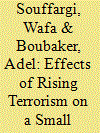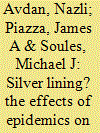| Srl | Item |
| 1 |
ID:
189403


|
|
|
|
|
| Summary/Abstract |
The purpose of this paper is to shed light on the impact of the rising terrorist threat on the performance of a small capitalization market – the Tunisian stock market-. Using an event study methodology as well as conditional volatility, we investigate the impact of recent terrorist attacks in Tunisia on the general index TUNINDEX and sector indices. Our main findings are as follows. First, we find that terrorist attacks negatively affect the Tunisian stock market. However, the decline – considerable in certain cases- is short-lived: the market recovers from terrorist shocks in one day. Second, Oil and Gas, Insurance and Telecommunications, are the most affected sectors. Third, different terrorist tactics have varied effects on the stock market that leads us to conclude that attack type, weapon type, target type, and severity of the attack may determine the market’s reactions.
|
|
|
|
|
|
|
|
|
|
|
|
|
|
|
|
| 2 |
ID:
124195


|
|
|
|
|
| Publication |
2013.
|
| Summary/Abstract |
The most outstanding trend in contemporary conflicts has been the fusion of the threats from terrorism and insurgency. Insurgent threats in many places on the globe today are mistaken as terrorist threats, and counterterrorism (CT) is deployed as the local insurgents come increasingly to resemble their transnational terrorist partners. Such an emphasis on the role of terrorism in insurgencies and the undue focus on CT risks strengthening, rather than severing, the connection between local insurgents and transnational terrorists. Russia's counterterrorist strategy inadvertently transformed the conflict from a contained, nationalist rebellion to a sprawling jihadi insurgency and perversely encouraged the group to resort even more to terrorist tactics. The Russian counterinsurgency has been unsuccessful, as the insurgents are neither demolished as a force nor are they isolated by society. Losing the hearts and minds among the Chechen people is a key reason behind why the Russian operation in Chechnya suffered failures. Too little attention was paid to winning over the "hearts and minds" of the people.
|
|
|
|
|
|
|
|
|
|
|
|
|
|
|
|
| 3 |
ID:
191050


|
|
|
|
|
| Summary/Abstract |
In this study we examine the effects of epidemics on terrorist groups’ attack capacities. We consider two theoretical relationships between epidemics and terrorist groups. By weakening government counterterrorism defenses and increasing popular grievances, epidemics can provide a strategic environment that is conducive to terrorist groups, enhancing their capacity to commit more attacks, yield higher casualties and launch more logistically complex attacks. Conversely, epidemics can impair the abilities of terrorist groups to launch attacks by eroding group capacity and access to resources while incentivizing the state to increase its surveillance and policing capabilities. We test these two competing arguments using a database of over 620 terrorist groups for the period of 1970 to 2016. Our findings support the second argument. Terrorist groups based or operating in countries experiencing more and more intense epidemics commit fewer attacks, generally produce fewer casualties, commit a lower ratio of transnational to domestic attacks and less frequently use multi-mode attacks. We conclude with a discussion of the implications of these findings.
|
|
|
|
|
|
|
|
|
|
|
|
|
|
|
|
| 4 |
ID:
092318


|
|
|
|
|
| Publication |
2009.
|
| Summary/Abstract |
Under what conditions did the social movement the Muslim Brotherhood resort to the use of terrorist tactics? Three factors led to the radicalization of the Muslim Brotherhood. Hasan al-Banna, the charismatic leader (as defined by Max Weber) and founder of the Muslim Brotherhood commanded the Brotherhood to use terrorism. Secondly, the Muslim Brotherhood radicalized because Hasan al-Banna himself was radicalized throughout time. The last factor that led to the radicalization occurred because the Brotherhood became more and more frustrated after each attempt to reform the Egyptian population failed. This accumulation of frustration led to the use of terrorist tactics.
|
|
|
|
|
|
|
|
|
|
|
|
|
|
|
|